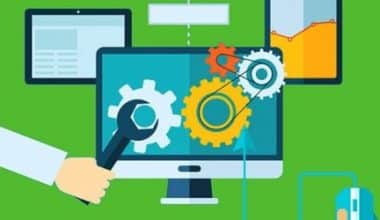The fleet of mobile devices in your organization may be managed and secured wirelessly using mobile device management tools without affecting the user experience. Modern Apple MDM solutions ensure employees can use managed devices without concern by regulating their access to apps, content, and security. The best mobile device management tools and software provide for efficient control of the Microsoft environment in the workplace. Furthermore, organizations rely on MDM’s complete kiosk configuration feature to safeguard sensitive company information stored on a one-off or limited-use devices while still granting users appropriate permissions to access necessary data and applications. The purpose of this article is to enlighten you on device management and its comparison chart
What Is a Mobile Device Management Tool?
Mobile device management (MDM) is a method and set of tools that have been used successfully to give mobile productivity tools and apps to a workforce while keeping corporate data safe.
Features of Mobile Device Management Tools
#1. Device Tracking
A business may install tracking software, such as GPS, on any device, it enrolls in its system or provides to its employees. Software like this enables IT staff to track, upgrade, and debug the device in real-time. As an added bonus, they may remotely lock or wipe a device if it is lost or stolen, as well as detect and notify a high-risk or non-compliant device.
#2. Protection at the Endpoints
Wearables, IoT sensors, and other non-conventional mobile devices are all included in the scope of endpoint security because they are all able to connect to a company’s network. Antivirus software, network access control, incident response, website filtering, and cloud security are all examples of commonplace network security solutions that may be used for endpoint protection.
#3. Mobile Management
The IT department is responsible for acquiring, deploying, managing, and supporting mobile devices for the workforce. These sections guarantee that every device ships with the appropriate operating system and set of apps, such as productivity, security, data protection, backup, and restoration software.
#4. Application Security
One method of protecting applications is called “app wrapping,” which involves adding extra controls and protections to an app by a system administrator. Once the application has been containerized, it is redeployed. These safeguards can establish whether or not the user must provide a password in order to launch an app, whether or not any information within the app can be saved locally, and whether or not the user can send a file to another user.
Best Mobile Device Management Software
When you have the best mobile device management software, keeping track of the safety of all of your mobile gadgets is a breeze. However, it takes a strong person to be in charge of a fleet of gadgets used by people in different fields and departments. There are tools in the form of mobile device management software, but what benefits will it bring your company, is it worth the investment, and will you have the amount of control you require?
Best mobile device management software, or MDM for short, is the practice of managing mobile devices. Increasingly, laptops and other mobile devices are also managed by MDM. In recent years, as BYOD has become more widespread, enterprise mobility management (EMM) systems have been incorporated into MDM. Here is the best mobile device management software
#1. Hexnode UEM
The Hexnode Unified Endpoint Management system has won multiple awards for its ability to provide comprehensive device management and security options for both BYOD and company-owned devices. Hexnode has a lot more in store to meet the needs of its customers, including support for a broad variety of use cases and a modular design that allows for easy customization. It works with Apple TV, Windows, Mac OS X, iOS, Android, and fireOS.
#2. ManageEngine MDM
Whether you’re hosting in the cloud or on-premises, ManageEngine has you covered. ManageEngine is compatible with the Chrome Operating System in addition to the more common Android, iOS, Windows, and macOS.
Furthermore, the ability to detect compromised devices, rooting, and even jailbreaking on iOS devices is a crucial part of this software’s security management. Standard features include the ability to remotely delete data and protect a company’s network from mobile-based attacks with individual access controls for each device and employee.
#3. Addigy
Addigy is a cloud-based IT management platform that helps managed service providers (MSPs) and in-house IT departments manage macOS, iOS, iPad, and tvOS devices for a wide variety of clients and locations. For IT service providers and enterprise IT teams, Addigy is the only multi-tenant Apple device management solution that offers a user-friendly platform with zero-touch provisioning, asset management, monitoring and automated remediation, remote access, software deployment, configuration management, and more.
#4. EasyControl MDM
EasyControl takes the use of a vertically integrated market to provide users with specialized MDM solutions from hardware vendors. In terms of mobile device and endpoint management, they are the best cloud platform available. Dedicated devices, COPE (company-owned, employee enabled), and BYOD (bring your own device) are just a few of the deployment models that EasyControl will offer (Bring Your Own Devices). Additionally, it’s a good fit for the health and fitness sector, as well as telehealth, logistics, education, and more.
Why Is Mdm Important?
With MDM, your firm’s data is safe and your company maintains control over sensitive data. Remotely locking and wiping a lost or stolen mobile device is one of MDM’s most useful features. Businesses may protect their data and devices with features like remote locking and wiping.
Mobile Device Management Microsoft
Now more than ever, BYOD is not just the way of the future, but the norm in today’s offices everywhere. The increasing prevalence of workers bringing their own devices to the office raises new concerns for IT departments, which must strike a delicate balance between user ease and data security. furthermore, enterprise Mobility Suite is one of several Microsoft services and device management used to centrally manage user accounts, mobile apps, and hardware. Effortless and seamless integration of current IT solutions guarantees that employees may be productive from any device.
This fad, however, has made it more difficult to secure data across a wide variety of mobile devices running on different operating systems. The Microsoft Configuration Manager is only compatible with Windows, macOS, and Windows Server machines in the workplace.
For this reason, Microsoft mobile device management released a product called Microsoft Intune. With Microsoft Intune, IT departments may control devices executing the most popular software, including Windows, macOS, iOS/iPadOS, and Android.
What Is Microsoft Mobile Device Management?
Mobile device management is a system for controlling mobile devices and their associated data (MDM). Microsoft provides businesses with a suite of tools and technology for remotely managing, accessing, and securing data held on devices owned by the business and by employees.
MEM is part of Microsoft 365 and includes Configuration Manager and Intune. These two solutions allow you complete control over data on any company- or employee-owned device. To store user/employee data, you also require Azure Active Directory (Azure AD). In addition, the endpoint manager retrieves and verifies Azure AD data before letting users access your enterprise network.
Microsoft Mobile Device Management Features
Microsoft’s mobile device management solution includes the following capabilities:
- Compatible With Safety and Protection Systems: Adding a third-party mobile threat protection system to your MDM ecosystem is another way to beef up security beyond integrating Microsoft Defender and Windows Defender.
- Intune Simplifies Mobile Device Management: A wide variety of popular OSes can be used with Intune. It is compatible with most of the market’s popular mobile, desktop, and server operating systems, allowing you to centrally control anything from your phone to your server. Furthermore, the endpoint manager provides a central location from which to administer user accounts and groups, making user and group management simple no matter the size of your business.
- Choices for Tenant Attachment and Co-management: Co-management and Tenant Attach are for enterprises that utilize on-premise configuration managers and want to transition slowly or not at all. Co-management lets you share MDM duties between Intune and the on-premise configuration manager. Using configuration management alone can limit the number of devices you can manage. Microsoft Configuration Manager only supports Windows, macOS, and Windows Server devices. In addition, Microsoft Endpoint Management may control your on-premise configuration manager using Tenant Attach.
What Is Microsoft Mobile Device Management Used For?
With the help of MDM services, you may establish rules for how your company’s devices should act when accessing private information. These rules specify how and under what conditions employees can access the company’s website or app after logging in. An employee who wants to use their own device at work must comply with these rules.
Mobile Device Management Comparison Chart
In the past two decades, the mobile industry has seen phenomenal growth. Many methods for regulating the surrounding atmosphere have thus developed. Management of mobile device and comparison chart, management of mobile applications, and management of enterprise mobility are the three primary subfields that have emerged in this space
Furthermore, EMM, of which MDM and MAM are subgroups, has their own distinguishing characteristics. IAM (identity access management) is similar but not identical to the other classifications. Device security is an ongoing battle, and mobile device management (MDM) comparison chart is an important weapon in this war. Here is the mobile device management comparison chart.
| Tool | OS/Platform | Module | Cloud(c)/ Both(B) | Pricing |
| Pulse Secure/ Pulse workspace | IOS, Andriod | An optional element of pulse one | B | Starts at $60/device/year |
| ManageEngine, mobile device manage plus | Runs on the window, Supports IOS, Android, Windows, TVOs | Works with other modules | B | Starts at $10/ device/ year |
| IBM Maa 360 with Watson | IOS, macOS, Andriod, Windows | Standalone | C | Starts at $4/ device/ Mo |
| Arxan/ Apperian | IOS/ Andriod | Standalone | C | $2. 83 |
| Appaloosa store | Android/ IOS | Standalone enterprise app sore | C | Varies |
| SOTI/ SOTI ONE platform | Andriod, IOS, Linux, Windows, macOS | Both | B | Varies |
| Microsoft Intune | Android, IOS, Windows 10 | Both | C | Starts at $4/ device/ Mo |
Which Mobile Device Management Tool Can Control Mobile Applications?
Mobile Device Manager Plus: this is a robust mobile device management tool that allows you to keep tabs on and secure all iOS, Android, Windows, and Chrome OS gadgets in your organization from a single location.
Apple MDM solutions
When we think back to our early workplaces, we typically see a cluster of stationary computers and other machinery at its heart. The majority of them relied on Windows. In recent years, however, that trend has shifted, and today, macs are increasingly accepted in our workplaces. However, this raises the already formidable problem of how to manage Macs in the workplace. Enterprise devices need to be adaptable in the face of issues like device and data security by providing options for deployment, app control, and even kiosk modes. Apple MDM solutions were so required.
As if that weren’t enough, apple mdm also have the extraordinary expansion of device management solutions to contend with. With so many solutions available, businesses can easily become perplexed when trying to select the optimal one for their unique needs.
Furthermore, It’s evident that you need Apple MDM solutions for your business to ensure the safety of your devices and data. There are several MDMs to choose from, making it challenging to narrow down your options and find the finest one. Here are some Apple MDM solutions to consider.
#1. Jamf
Jamf is a complete device management solution created for the Apple ecosystem. It is geared toward automating the Apple device management lifecycle and tailoring Apple devices to individual users’ requirements without compromising the coveted Apple user experience. However, with Jamf, you can connect Apple users, manage Apple devices, and safeguard Apple endpoints with MDM solutions. The alternatives like cloud or in-premise give versatile deployment options for multiple use cases. Integrations with asset management software, network access controllers, and other IT services extend its usefulness.
#2. Watson, IBM’s Security MaaS360
MaaS360 streamlines device management with rapid deployment, full visibility, and control that spans numerous platforms. It supports most devices like iPhone, iPad, Android, Windows Phone, macOS, Windows, etc. It’s a simple UEM solution that can be integrated with your existing security and productivity solutions. As an added bonus, Watson’s AI capabilities make it simpler to safeguard your workers with cutting-edge threat management tools and analytical insights using this apple mdm solutions called MaaS360.
#3. Kandji
Kandji is an Apple-specific platform for managing and securing your devices throughout their useful lives. Powerful tools and time-saving automation are available for a wide range of tasks, including device deployment, security, configuration, and management. There are OS X, iOS, iPad OS, and Apple TV 4K support options. It’s easier to manage the complete fleet of devices because it integrates with identity providers, compliance automation solutions, software monitors, etc.
#4. Addigy
Addigy is a platform for managing macOS, iOS, iPadOS, and tvOS devices. Multi-tenant device management solution with zero-touch provisioning, asset management, monitoring, automatic remediation, remote access, configuration management, and more. furthermore, it integrates with ConnectWise Manage, Autotask, Zendesk, and more. Its 150+ automation includes automated patching, compliance templates, and a macOS agent that fixes offline Mac devices.
Which Is the Best Mdm?
Baramundi management suite is the best MDM to consider.
What Are the Benefits of Mdm?
Below are the benefits of MDM
- It enables auto backup
- Enhances security
- Better application control
- It helps in device tracking
- It saves cost
Mobile Device Management Tools List
On the market, you’ll find some fantastic MDM solutions, and the vast majority of them are compatible with other network administration tools. Furthermore, employees’ reliance on mobile smart devices, however, can introduce new security holes into the network. It is critical for managers to have oversight of all company-issued devices, and MDM solutions are an excellent way to do just that. Here is the list of mobile device management tools list
- Cisko Meraki: Features a container system to ship programs to personally-owned gadgets and offers safeguards against theft.
- Citrix Endpoint Management: Support for Windows 10, macOS, iOS, tvOS, iPadOS, Android, Android Enterprise, Chrome OS, and Citrix is a must for any MDM system.
- Kandji: The cloud service is tailored specifically for Apple gadgets and uses agents to communicate with users’ devices.
- Simply Secure: Mobile device management (MDM) service that works with iOS and Android smartphones and USB drives.
- Jamf Now: A remote administration platform that is compatible with iOS devices alone.
Which Mobile Device Management Tool Manages the Content on Mobile Devices?
Mobile device management software, often known as an MDM solution, is a sort of management or security technology that helps IT administrators keep track of, manage, and secure mobile devices, whether they are owned by the company, the employee, or the individual.
Who Uses Mobile Device Management (MDM) Software?
The majority of MDM solution users are internal IT teams. MDM software provides consumers with a significant benefit over more basic IT asset management software because it is more in-depth on mobile devices. As part of the whole security ecosystem, IT security professionals also use MDM solutions to secure data and assist stop corporate information from getting into the wrong hands through a lost or stolen device.
Why Do Very Few People Know About Mobile Device Management?
MDM software is a corporate service, and mobile devices are viewed as the user’s personal property that they carry with them wherever they go. Many businesses overlook the potential of their mobile devices to access their data in favor of fixed hardware that connects to their network from inside their structure. Businesses are starting to understand that even though a device is owned by the users, they still have the right to govern it when it accesses their network resources.
Are Mdm Tools Compatible With All Types of Mobile Devices?
The operating system of mobile devices, not the type of device, is a key component in determining compatibility with MDM systems. Smartphones and tablets can both be used in conjunction with an MDM that can manage Android devices. This is due to the operating system’s dependence on the command set the MDM employs to manage devices.
Which MDM Solution Is Best for You?
Consider your actual demands before choosing an MDM solution because less expensive choices could appear alluring due to cost-effectiveness but lack crucial tools. Additionally, more advanced software can really meet all of your needs, so make sure you have a strong concept of the capabilities your MDM solution should offer.
Conclusion
The importance of mobile device management solutions cannot be overstated now that businesses are free to operate in a far wider variety of locations. It used to be that MDM was a nice-to-have, but now it’s a must-have. The reason is, that businesses now rely extremely on data to function. MDM is now an integral part of most businesses’ routine operations. In addition, corporations have turned to remote working solutions in response to adversity, such as pandemics and natural disasters.
Mobile Device Management Tools FAQs
What types of things are you looking for in an MDM solution?
- Software distribution
- Security Management
- Device support
- Service Management
What is secure device management?
Organizational resources and data are more secure when managed across a variety of devices. A device control service helps businesses restrict access to sensitive data to authorized personnel and equipment.
How do you define device management?
When talking about an OS, “device management” refers to the process of adjusting settings for I/O devices like a hard drive, microphone, keyboard, printer, magnetic tape, USB ports, camcorder, scanner, and other peripherals.
What is MDM setting?
With ContentProtect MDM, you can remotely manage Android and iOS devices in your business and make changes to their settings and configurations. Therefore, your IT department spends less time and energy supporting and configuring mobile devices.





